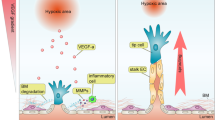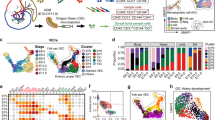Abstract
After the developing embryo has formed a primary vascular plexus by a process termed vasculogenesis, further blood vessels are generated by both sprouting and non-sprouting angiogenesis, which are progressively pruned and remodelled into a functional adult circulatory system. Recent results, particularly from the study of mice lacking some of the signalling systems involved, have greatly improved our understanding of the molecular basis underlying these events, and may suggest new approaches for treating conditions such as cancer that depend on angiogenesis.
This is a preview of subscription content, access via your institution
Access options
Subscribe to this journal
Receive 51 print issues and online access
$199.00 per year
only $3.90 per issue
Buy this article
- Purchase on Springer Link
- Instant access to full article PDF
Prices may be subject to local taxes which are calculated during checkout
Similar content being viewed by others
References
Risau, W. & Flamme, I. Vasculogenesis. Annu. Rev. Cell Dev. Biol. 11, 73–91 (1995).
Mustonen, T. & Alitalo, K. Endothelial receptor tyrosine kinases involved in angiogenesis. J. Cell Biol. 129, 895–898 (1995).
Folkman, J. Angiogenesis in cancer, vascular, rheumatoid and other disease. Nature Med. 1, 27–31 (1995).
Shalaby, F. et al. Failure of blood-island formation and vasculogenesis in flk-1-deficient mice. Nature 376, 62–66 (1995).
Porcher, C. et al. The T cell leukemia oncoprotein Scl/Tal-1 is essential for development of all hematopoietic lineages. Cell 86, 47–57 (1996).
Robb, L. et al. The Scl gene product is required for the generation of all hematopoietic lineages in the adult mouse. EMBO J. 15, 4123–4129 (1996).
Fong, G. H., Rossant, J., Gertsenstein, M. & Breitman, M. L. Role of the flt-1 receptor tyrosine kinase in regulating the assembly of vascular endothelium. Nature 376, 66–70 (1995).
Carmeliet, P. et al. Abnormal blood vessel development and lethality in embryos lacking a single VEGF allele. Nature 380, 435–439 (1996).
Ferrara, N. et al. Heterozygous embryonic lethality induced by targeted inactivation of the VEGF gene. Nature 380, 435–439 (1996).
Breier, G. & Risau, W. The role of VEGF in blood vessel formation. Trends Cell Biol. 6, 454–456 (1996).
Pardanaud, L. et al. Two distinct endothelial lineages in ontogeny, one of them related to hemopoiesis. Development 122, 1363–1371 (1996).
Noden, D. M. in The development of the vascular system (eds Feinberg, R. N., Sherer, G. K. & Auerbach, R.) 1–24 (Karger, Basel, 1991).
Risau, W. What, if anything, is an angiogenic factor. Cancer Metast. Rev. 15, 149–151 (1996).
Short, R. H. D. Alveolar epithelium in relation to growth of the lung. Phil. Trans. R. Soc. Lond. B 235, 35–87 (1950).
Patan, S., Haenni, B. & Burri, P. H. Implementation of intussusceptive microvascular growth in the chicken choriollantoic membrane. 1. Pillar formation by folding of the capillary wall. Microvasc. Res. 51, 80–98 (1996).
Pardanaud, L., Yassine, F. & Dieterlen-Lievre, F. Relationship between vasculogenesis, angiogenesis and hematopoiesis during avian ontogeny. Development 105, 473–485 (1989).
Drake, C. J. & Little, C. D. Exogenous vascular endothelial growth-factor induces malformed and hyperfused vessels during embryonic neovascularization. Proc. Natl Acad. Sci. USA 92, 7657–7661 (1995).
Sato, T. N. et al. Distinct roles of the receptor tyrosine kinases tie-1 and tie-2 in blood-vessel formation. Nature 376, 70–74 (1995).
Puri, M. C., Rossant, J., Alitolo, K., Bernstein, A. & Partanen, J. The receptor tyrosine kinase tie is required for integrity and survival of vascular endothelial-cells. EMBO J. 14, 5884–5891 (1995).
Davis, S. et al. Isolation of angiopoietin-1, a ligand for the TIE2 receptor, by secretion-trap expression cloning. Cell 87, 1161–1169 (1996).
Suri, C. et al. Requisite role of angiopoietin-1, a ligand for the TIE2 receptor, during embryonic angiogenesis. Cell 87, 1171–1180 (1996).
Yamaguchi, T. P. et al. Flk-1, an flt-related receptor tyrosine kinase is an early marker for endothelial-cell precursors. Development 118, 489–498 (1993).
Ashton, N. Oxygen and the growth and development of retinal vessels. Am. J. Ophthalmol. 62, 412–435 (1966).
Augustin, H. G., Braun, K., Telemenakis, I., Modlich, U. & Kuhn, W. Ovarian angiogenesis-phenotypic characterization of endothelial-cells in a physiological model of blood-vessel growth and regression. Am. J. Pathol. 147, 339–351 (1995).
Alon, T. et al. Vascular endothelial growth-factor acts as a survival factor for newly formed retinal-vessels and has implications for retinopathy of prematurity. Nature Med. 1, 1024–1028 (1995).
Markwald, R. R. et al. in The Embryonic Origins of Defective Heart Development (eds Bockman, D. E. & Kirby, M. L.) 13–25 (Ann. NY Acad. Sci., New York, 1990).
Henkemeyer, M. et al. Vascular system defects and neuronal apoptosis in mice lacking Ras GTPase-activating protein. Nature 307, 648–649 (1984).
Franke, R. P. et al. Induction of human vascular endothelial stress fibres by fluid shear stress. Nature 307, 648–649 (1984).
Resnick, N. & Gimbrone, M. A. Hemodynamic forces are complex regulators of endothelial gene-expression. FASEB J. 9, 874–882 (1995).
Risau, W. Differentiation of endothelium. FASEB J. 9, 926–933 (1995).
Strömblad, S. & Cheresh, D. A. The role of cell adhesion molecules in angiogenesis. Trends Cell Biol. 6, 462–468 (1996).
Dickson, M. C. et al. Defective hematopoiesis and vasculogenesis in transforming growth-factor-beta-1 knockout mice. Development 121, 1845–1854 (1995).
Johnson, D. W. et al. Mutations in the activin receptor-like kinase 1 gene in hereditary haemorrhagic telangiectasia type 2. Nature Genet. 13, 189–195 (1996).
Carmeliet, P. et al. Role of tissue factor in embryonic blood vessel development. Nature 383, 73–75 (1996).
Antonelli-Orlidge, A., Saunders, K. B., Smith, S. R. & D'Amore, P. A. An activated form of transforming growth factor-β is produced by cocultures of endothelial-cells and pericytes. Proc. Natl Acad. Sci. USA 86, 4544–4548 (1989).
Folkman, J. Seminars in medicine of the Beth Israel hospital, Boston—clinical applications of research on angiogenesis. N. Engl. J. Med. 333, 1757–1763 (1995).
Oreilly, M. S. et al. Angiostatin—a circulating endothelial-cell inhibitor that suppresses angiogenesis and tumor growth. Cell 59, 471–482 (1994).
Shweiki, D., Itin, A., Soffer, D. & Keshet, E. Vascular endothelial growth factor induced by hypoxia may mediate hypoxia-initiated angiogenesis. Nature 359, 843–845 (1992).
Plate, K. H., Breier, G., Weich, H. A. & Risau, W. Vascular endothelial growth factor is a potential tumour angiogenesis factor in human gliomas in vivo. Nature 359, 845–848 (1992).
Semenza, G. L. Transcriptional regulation by hypoxia-inducible factor 1—molecular mechanisms of oxygen homeostasis. Trends Cardiovasc. Med. 6, 151–157 (1996).
Stein, I., Neeman, M., Shweiki, D., Itin, A. & Keshet, E. Stabilization of vascular endothelial growth-factor messenger RNA by hypoxia and hypoglycemia and coregulation with other ischemia-induced genes. Mol. Cell. Biol. 15, 5363–5368 (1995).
Wizigmann-Voos, S., Breier, G., Risau, W. & Plate, K. H. Up-regulation of vascular endothelial growth factor and its receptors in Von Hippel-Lindau disease-associated and sporadic hemangioblastomas. Cancer Res. 55, 1358–1364 (1995).
Iliopoulos, O., Levy, A. P., Jiang, C., Kaelin, W. G. & Goldberg, M. A. Negative regulation of hypoxia-inducible genes by the Von Hippel Lindau protein. Proc. Natl Acad. Sci. USA 93, 10595–10599 (1996).
Gnarra, J. R. et al. Post-transcriptional regulation of vascular endothelial growth factor mRNA by the product of the VHL tumor suppressor gene. Proc. Natl Acad. Sci. USA 93, 10589–10594 (1996).
Samakovlis, C. et al. Development of the Drosophila tracheal system occurs by a series of morphologically distinct but genetically coupled branching events. Development 122, 1395–1407 (1996).
Wilk, R., Weizman, I. & Shilo, B. Z. Trachealess encodes a bHLH-PAS protein that is an inducer of tracheal cell fates in Drosophila. Genes Dev. 10, 93–102 (1996).
Guillemin, K. et al. The pruned gene encodes the Drosophila serum response factor and regulates cytoplasmic outgrowth during terminal branching of the tracheal system. Development 122, 1353–1362 (1996).
Stone, J. et al. Development of retinal vasculature is mediated by hypoxia-induced vascular endothelial growth factor (VEGF) expression by neuroglia. J. Neurosci. 15, 4738–4747 (1995).
Kim, K. J. et al. Inhibition of vascular endothelial growth factor-induced angiogenesis suppresses tumour growth in vivo. Nature 362, 841–844 (1993).
Millauer, B., Shawver, L. K., Plate, K. H., Risau, W. & Ullrich, A. Glioblastoma growth inhibited in vivo by a dominant-negative Flk-1 mutant. Nature 367, 576–579 (1994).
Millauer, B. et al. Dominant-negative inhibition of Flk-1 suppresses the growth of many tumor types in vivo. Cancer Res. 56, 1615–1620 (1996).
Hanahan, D. & Folkman, J. Patterns and emerging mechanisms of the angiogenic switch during tumorigenesis. Cell 86, 353–364 (1996).
Graeber, T. G. et al. Hypoxia-mediated selection of cells with diminished apoptotic potential in solid tumours. Nature 379, 88–91 (1996).
Rights and permissions
About this article
Cite this article
Risau, W. Mechanisms of angiogenesis. Nature 386, 671–674 (1997). https://doi.org/10.1038/386671a0
Issue Date:
DOI: https://doi.org/10.1038/386671a0
This article is cited by
-
Inhibition of MMPs supports amoeboid angiogenesis hampering VEGF-targeted therapies via MLC and ERK 1/2 signaling
Journal of Translational Medicine (2023)
-
Aging microenvironment and antitumor immunity for geriatric oncology: the landscape and future implications
Journal of Hematology & Oncology (2023)
-
Fetal pulmonary hypertension: dysregulated microRNA-34c-Notch1 axis contributes to impaired angiogenesis in an ovine model
Pediatric Research (2023)
-
HuMSC-EV induce monocyte/macrophage mobilization to orchestrate neovascularization in wound healing process following radiation injury
Cell Death Discovery (2023)
-
Diverse effects of prostacyclin on angiogenesis-related processes in the porcine endometrium
Scientific Reports (2023)
Comments
By submitting a comment you agree to abide by our Terms and Community Guidelines. If you find something abusive or that does not comply with our terms or guidelines please flag it as inappropriate.



